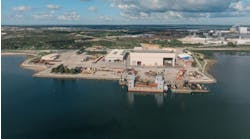Offshore staff
LONDON – Neptune Energy will conduct a feasibility study for a large-scale carbon capture and storage (CCS) project in the Dutch North Sea, in co-operation with its license partners and various “CO2 emitters.”
The aim is to achieve safe subsurface storage of 120-150 MM metric tons (132-165 MM tons) of CO2. It would involve injecting between 5 and 8 MM metric tons (5.5 and 8.8 MM tons) of CO2 annually into depleted gas fields around the Neptune-operated L10-A, L10-B, and L10-E areas.
If the project does go forward, it would be one of the largest CCS facilities in the Dutch North Sea, achieving more than 50% of the CO2 reduction that the Dutch industrial sector is targeting.
According to the company, the Dutch North Sea could potentially serve as a new energy hub, due to the fact that so much of the existing hydrocarbons-related infrastructure connects offshore with onshore.
Neptune’s Q13a platform will also host the world’s first offshore green hydrogen pilot, PosHYdon.
The company has existing experience with CCS via a 14-year project on its K12-B platform that involved reinjecting CO2 into the gas field. This was a partnership with TNO, the Netherlands organization for applied scientific research.
Lex de Groot, managing director in the Netherlands, said: “The first step is a feasibility study to confirm that CO2 can be handled and stored safely in these depleted gas reservoirs, using our existing infrastructure. We will engage with organizations and emitters to offer safe and competitively priced CO2 storage.”
Jan Willem van Hoogstraten, CEO of Energie Beheer Nederland (EBN), added: “We are already making great strides with the Porthos and Athos projects that want to store CO2 in empty gas fields off the coast of Rotterdam and Ijmuiden, respectively.”
Other partners in the L10 license are EBN, Rosewood Exploration, and XTO Netherlands.
12/10/2020



